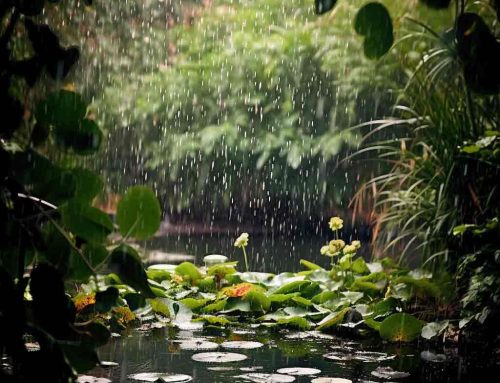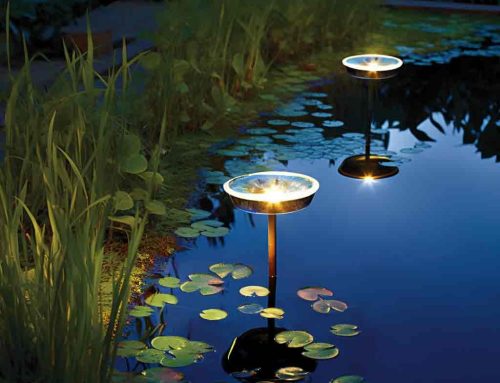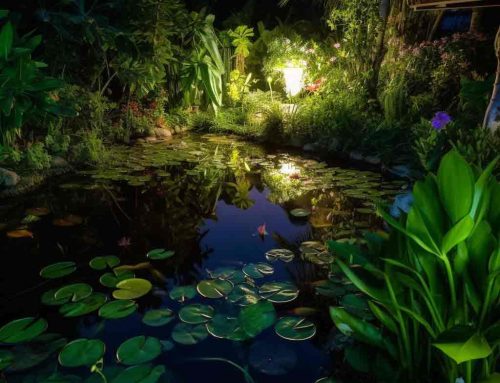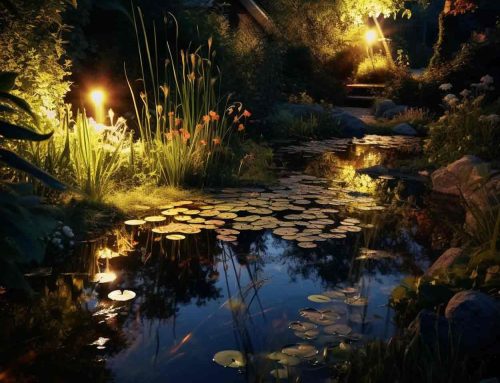 With the hole dug, the pond itself installed and the bulk of the physical labour behind you, edging the pond marks the start of a rather more “artistic” phase in the project. Since the edging you choose will probably define the overall appearance of your pond more than any other single element, it is as well to have given some serious thought to what you intend to use.
With the hole dug, the pond itself installed and the bulk of the physical labour behind you, edging the pond marks the start of a rather more “artistic” phase in the project. Since the edging you choose will probably define the overall appearance of your pond more than any other single element, it is as well to have given some serious thought to what you intend to use.
Picking Your Materials for pond edging
Paving slabs form one of the most popular materials for edging and if done well, look very good, especially around a semi-formal pond. They should be laid slightly overhanging the pond by an inch or so – the shade helps protect the liner from being damaged by the UV in sunlight – and bedded into a firm concrete bed, to stop them being tipped up by anyone walking near the edge. If the cement around the finished edge is ever likely to come into contact with the water, it should be waterproofed with a proper sealant made for the purpose – and care should be taken when doing the work that no cement is allowed to run into the pond.
Slabs which have been laid with no gaps between them will need some provision to be made to let animals get out, even if it is not a wildlife pond as such. Garden ponds attract a wide range of creatures, especially at night and inevitably from time to time, something will fall in. Finding little drowned bodies floating there the next morning is not a pleasant sight – but a strategically placed log or stone to act as a ramp can usually solve the problem without spoiling the over all look. Alternatively, if the cement bed is deep enough, a few large pipes can be laid beneath the paving slabs, to act as escape tunnels.
Informal pond edging
For a more informal pond, large pebbles or rockery stones set into a concrete pad make a change from the more usual slabs – and avoid any problems of trapped wildlife. However, this is more difficult to do as the cement needs to go right up to the pond’s edge and, of course, will need to be sealed, but this kind of edging can be a very striking feature if your concreting skills are up to it and the starkness can be softened with appropriate planting. Careful planting is key to a natural looking edge, with marginal plants and pond edge plants helping to blur the hard edges between the pond and the garden.
Turf can be successfully used if the lawn is to extend right up to the pond and letting the grass beside the pond grow longer creates the right effect, particularly for a wildlife pond as well as making it easier for frogs and other visitors to make their way in and out of the water. If you do decide to use grass, a good tip is to make a small drainage ditch first, about six or eight inches away from the pond. When filled with fairly coarse gravel, it will help stop the edge becoming too waterlogged and prevent soil and lawn feed from being washed into the water – which could end up promoting algal growth.
Formal pond edging
Paving laid very square and level can look very effective around a formal pond, as can a low wall to finish off the edge – though it is probably not a good option where children or the infirm could possibly trip over it. Anything from one or two bricks to perhaps a foot or so in height, the wall can be brick or block work and the side facing the pond should be cement rendered and waterproofed, taking care, as always, to avoid letting cement or mortar contaminate the water. As a variation on this idea, a second wall built just behind the first and filled with soil allows for planting, which is one solution for the koi enthusiast who also wants to be able to have some ornamental pond plants – given the habit this fish has of pulling up vegetation. Trailing plants can be used to soften the edges if a less geometric look is wanted or more upright types if the formal lines of the pond are to be kept.
Given the growing popularity of decking in our gardens, it should come as no real surprise that increasing numbers of ponds are being finished off with wood – square cut wood being particularly effective at echoing the straight-sided geometry of formal ponds.
While the whole question of edging is essentially cosmetic rather than constructional, from an aesthetic point of view, this is the one aspect that can make or break a pond in terms of how it fits into the overall design of the garden – so choose wisely!
Further reading: All about pond edging.
After installing a pond or even if you are building one from scratch, edging is added in order to assist the pond to blend with its surroundings. Normally, edging could be done with pebbles and plants making the pond look complete and closer to nature. However, there is not one particular way of doing it; rather play with the options you have to decorate your pond as you like.
Normally pond edges have rocks, pebbles and gravel casually lying around it which gives it a nice look but it demands maintenance in the long run as these are not glued to the edges. It covers those lines that separate the pond with the garden, making it one with the greenery around. If you choose this casual look, be more creative with the big rocks and create a waterfall or stack them together to guide the birds so they can sit on these rocks. Make sure that the rocks selected have smooth edges which won’t harm the birds or other wildlife. Smooth rocks will also keep your pond liner safe from any cuts. It is better to plan the layout before you start moving the rocks as it will be difficult to move the big rocks around.
Pond Edge Plants:
Another great way edging your pond is plants! They not only add magical ripples in the still water of the pond but thrive in that environment too. Bog plants which love water, can be planted to enhance the beauty of your pond. Plants will then invite wildlife too, painting a perfect picture. Water lilies and other such flowering plants attract bees too, however, cleaning the pond to remove petals will have to be done.
If you are a fan of greenery, you can add grass along the edges to make it all look seamless. If you end up using grass for the edges, make sure that you mow the grass carefully as it is very easy for grass clippings to fall in the water. You must have a picture in your head by now of what you want your pond to look like. Select the options that suit your pond and work with your creativity to make your pond a beautiful safe haven! View the range of pond edge plants
Adding an edge to your pond can help to create a neat and tidy appearance, as well as provide a practical barrier to prevent soil erosion and protect your pond liner.
If you’re looking for a natural and rustic look, natural stone edging can be an excellent choice. This option offers a wide range of colours and textures, and can be used to create a more organic and naturalistic appearance. Alternatively, brick or concrete edging can provide a more formal and structured look, which may be more appropriate for certain garden styles.
When it comes to installing your pond edging, there are a few things to keep in mind. First, ensure that the edging is level and stable, and that it fits tightly against the edge of the pond. You may need to dig a trench around the perimeter of the pond to ensure a secure fit.
Overall, adding an edge to your pond can be a great way to enhance its appearance and protect its integrity. With a little planning and effort, you can create a beautiful and functional pond edge that complements your garden and your personal style.
What is the best material for lining a pond?
EPDM Pond Liner is one of the top choices for water gardening as it is highly flexible, puncture-resistant, and long-lasting. For larger ponds, polyethylene liners are recommended as they are lightweight, less expensive than rubber, and can be made up to 60,000 sq. ft.
How can you hide the edge of a preformed pond?
Bricks, pavers, flat slate, or hewn rock can be used to cover the edge of a preformed pond. Their flat surfaces make it easy to fit them together to form a low border that can sit naturally on the soil or be placed on a base of sand to keep the bottom layer level.
How can you edge a preformed pond in the UK?
To edge a preformed pond in the UK, use bricks, pavers, flat slate, or hewn rock to form a low border around the edge as above
Is it necessary to put rocks around a pond?
Adding rocks to your pond provides a place for aerobic bacteria to colonise and start filtering out debris like fish waste and plant debris. Aerobic bacteria require the presence of ammonia and oxygen in your pond. However, it is not necessary to add rocks around your pond.
Do pond plants need to be in baskets?
If your pond has plant shelves, it is recommended to plant in baskets for easier pond plant care in the future. However, if your pond has been built with natural planting areas such as marsh areas, baskets may not be necessary.
How can you landscape around a pond?
When landscaping around a pond, aim for a natural look by planting flowers and trees that complement the surroundings. Plant plants between the rocks of the pond as well as around it, including moss-type and creeping plants.
How can you decorate around a farm pond?
To decorate around a farm pond, edge it with stones or bricks that overhang the edge by one or two inches. Create a six-inch-high shelf around the perimeter of the pond where rocks and boulders can hide the liner.
What should be the depth of the edge of a pond?
A healthy garden pond should have an edge depth of around 46cm / 18 inches, while a successful koi pond or pond with larger fish should have a depth of at least 90cm / 3 feet.
How can you level the edges of a pond?
To level the edges of a pond, dig a rim around the outside perimeter wide and deep enough to seat your edging material. Slightly lowering the ground bordering your pond will also allow rain and irrigation water to drain away from it.









Hi I’ve got epdm lined pond and will be edging it with clay tiles. The edge laps up and over a berm (highwater point) and will run a 3rd under the tiles with mortar bed holding all in place. What add mixture should I put in the mortar to minimise water ingress. Also how to seal mortar haunch at interface with liner. Don’t want all tiles popping off at first frost. Thanks
I need to slab around a Blagdon Pond that is sunken into grass. It is a funny shape and I don’t want any plastic to show. About 12″ wide slabs. The pond is called Mayfly 500.
Good morning , i need to re lay the flags around the pond , but don’t want to alter the ph of the water in case any cement gets in , therefore could you recommend a product to add to the cement . Thanking you
Hi I’ve just placed copping stones around pond. However some cement has gone in water. Its cloudy anything I can do to solve issue before I add plants n fish
Hi, we would like to build a pond from sleepers. Two sides will be raised relative to the ground around it, and two sides will be set into a flower bed (the site is slightly sloping). My question is, should we build a wall of sleepers all the way around, even though on two sides they will be surrounded by earth? I am worried that this might make them rot. Would the alternative be to dig into the soil and have two walls of soil, two walls of sleepers, then top the whole thing off with a row of sleepers all the way around? Or would the sleepers sitting on the soil not make a firm enough frame? Thanks, Rachel
This is my first pond.worried I overfed the fish cause the water gone brown.do I have to cover the top of the pond with slabs.when I bought the pond I was told 16 goldfish,I put 20,have I overcrowded it .do I need to buy something to clear the water and help lower the algae
Desperate for ideas on how to improve our pond edging! Currently oval slabs layered around edge – atop bricks. Looks absolutely dreadful. Can I send a photo?!
What product would you recommend to seal the cement between the rockery that is beside our pond so that it does leak into pond